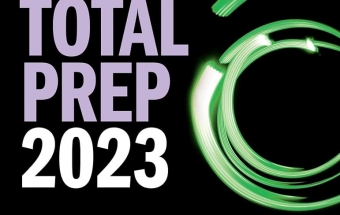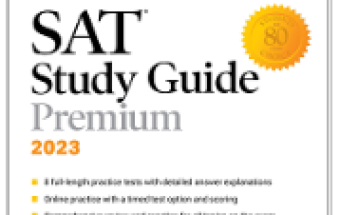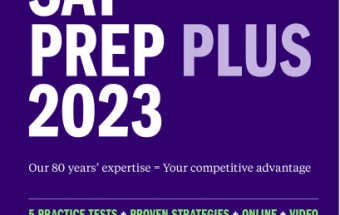SAT® Total Prep 2023 - Reading Test
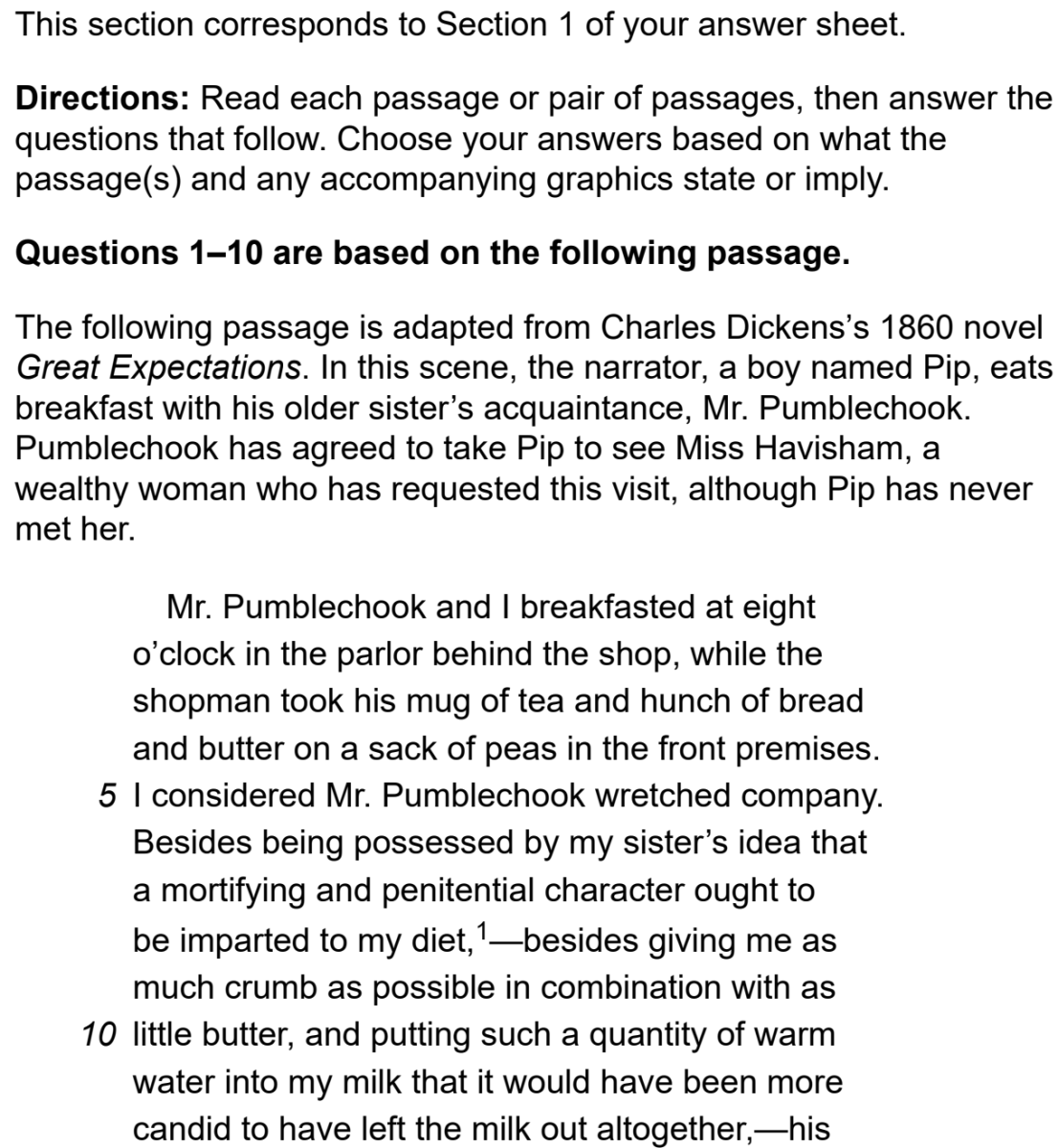
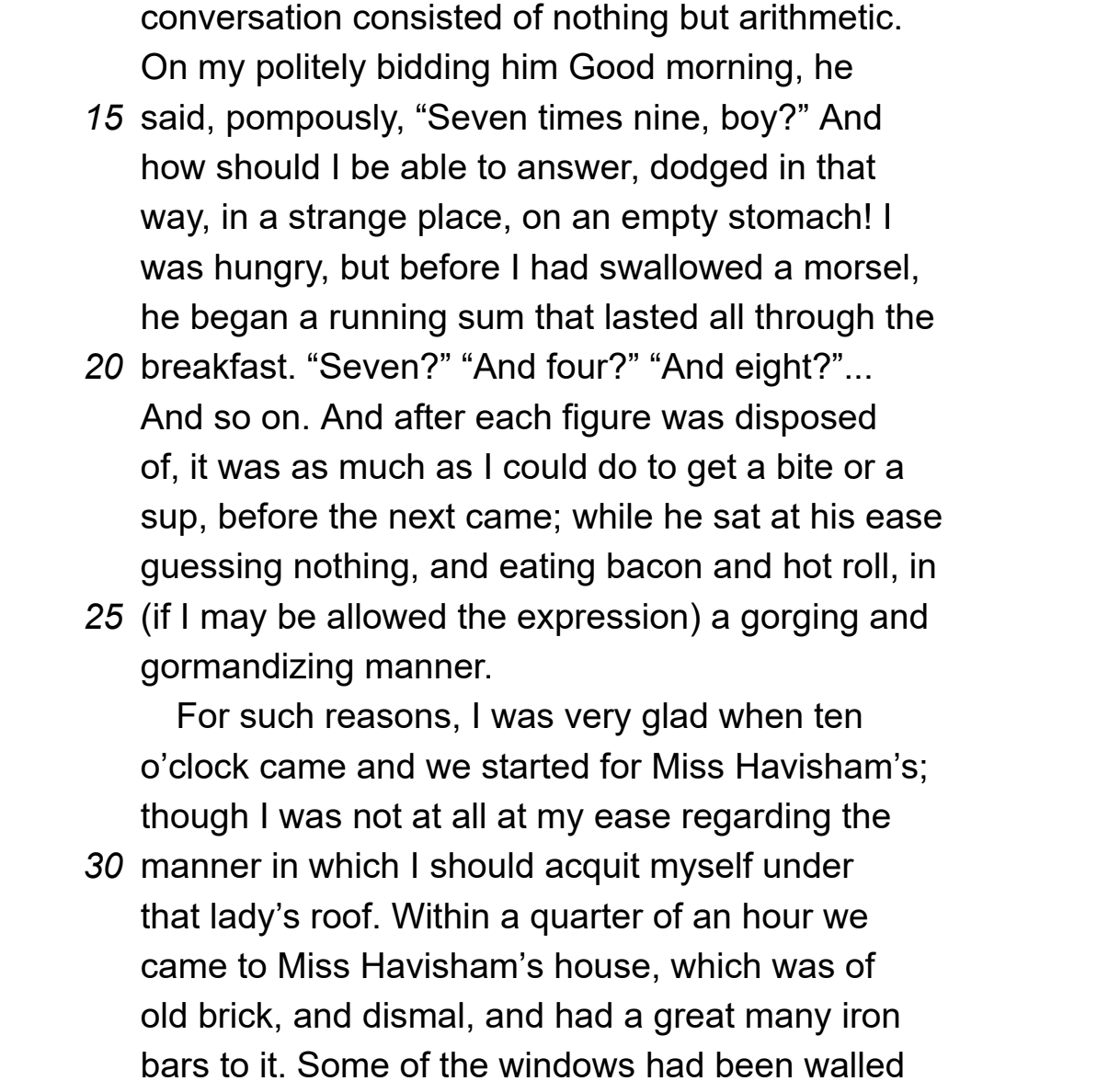
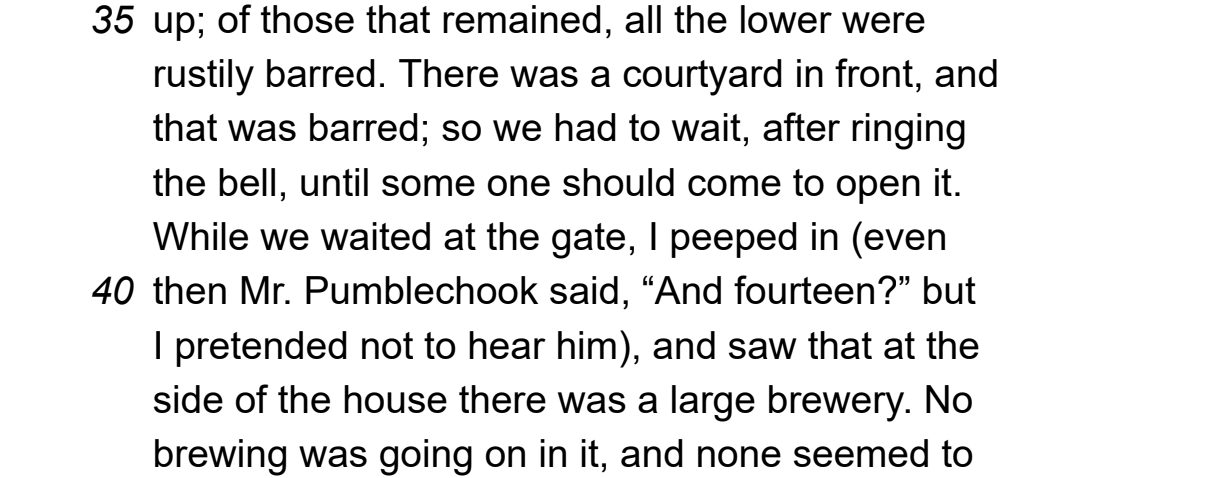

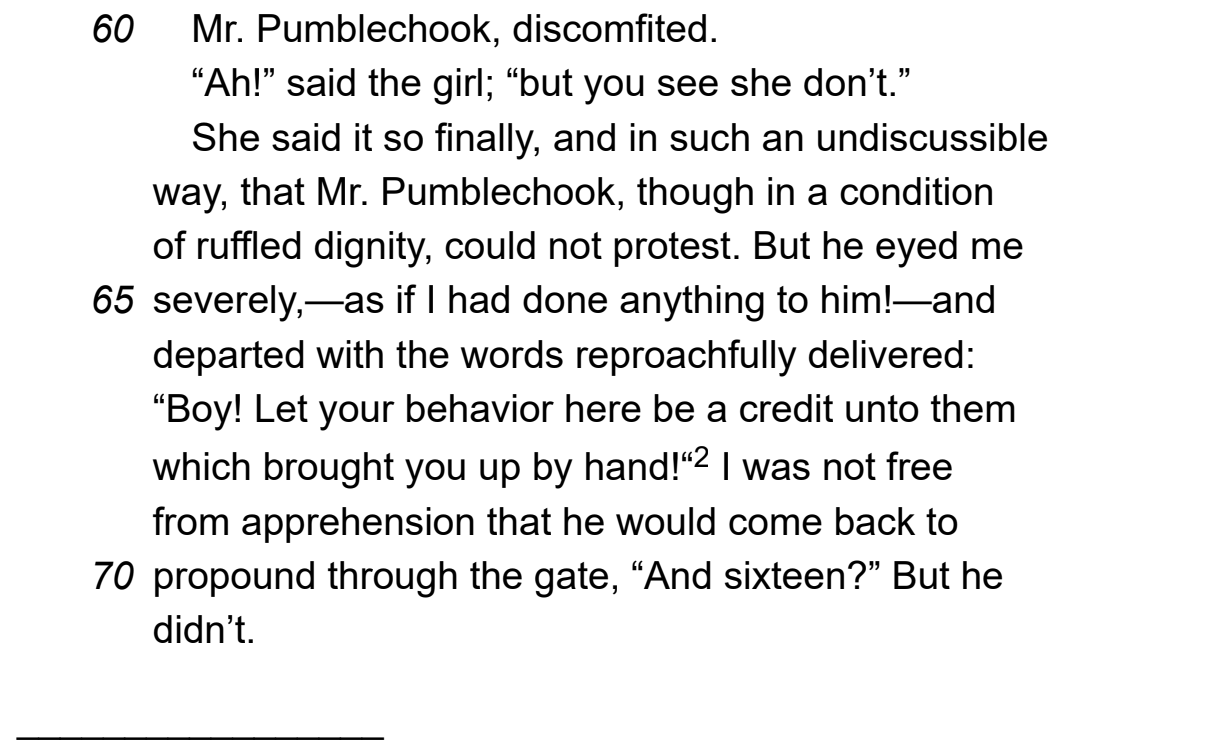

1. According to the first paragraph, Pip’s breakfast with Mr. Pumblechook is
A) eaten on the run.
B) small and of poor quality.
C) better than Pip usually receives.
D) carefully cooked and served.
2. As used in line 5, “wretched” most nearly means
A) shameful.
B) deprived.
C) distressing.
D) heartbroken.
3. Based on the passage, it can be inferred that Mr. Pumblechook
A) has looked forward to his morning with Pip.
B) is as uncomfortable as Pip is during breakfast.
C) has known Pip and his sister for a very long time.
D) is indifferent to Pip’s discomfort during breakfast.
4. Which choice provides the best support for the answer to the previous question?
A) Lines 1–4 (“Mr. Pumblechook and I . . . premises”)
B) Lines 6–13 (“Besides . . . arithmetic”)
C) Lines 46–47 (“To which my . . . ‘Pumblechook’”)
D) Lines 62–64 (“She said . . . not protest”)
5. What theme is communicated through the experiences of Pip, the narrator?
A) The world can be a puzzling and sometimes cruel place.
B) Young people are misunderstood by their elders.
C) Mean-spirited people deserve to be treated harshly.
D) The favors one receives in life should be reciprocated.
6. Which word best describes the young lady’s demeanor when she approaches Pip and Mr. Pumblechook?
A) Rude
B) Timid
C) Self-centered
D) Authoritative
7. Which of the following is true when Mr. Pumblechook leaves Pip at Miss Havisham’s house?
A) Pip is excited to finally meet Miss Havisham.
B) Pip is nervous about being away from his sister for so long.
C) Pip is relieved to be away from Mr. Pumblechook.
D) Pip is anxious about spending time with the young lady who greets them.
8. Which choice provides the best support for the answer to the previous question?
A) Lines 1–4 (“Mr. Pumblechook . . . premises”)
B) Lines 45–46 (“A window . . . name”)
C) Lines 62–64 (“She said . . . not protest”)
D) Lines 68–71 (“I was not . . . he didn’t”)
9. As used in line 63, “condition” most nearly means
A) illness.
B) prerequisite.
C) state.
D) limitation.
10. The function of the parenthetical comment in line 25 is to reveal that
A) Pip is usually more polite in his references to others.
B) Mr. Pumblechook appreciates gourmet food.
C) Pip is very angered that his own breakfast is so meager.
D) Mr. Pumblechook has no qualms about overeating in public.
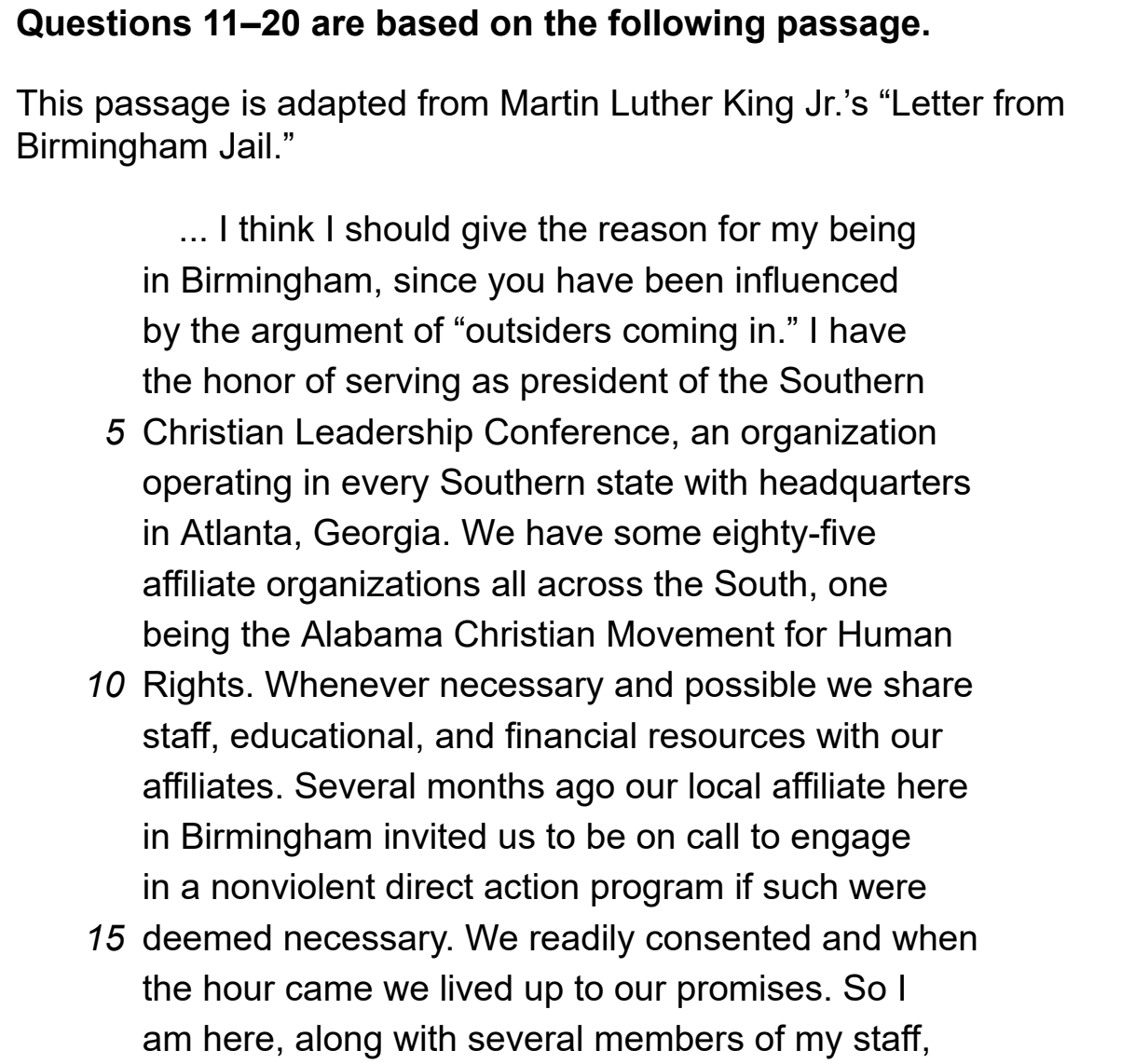
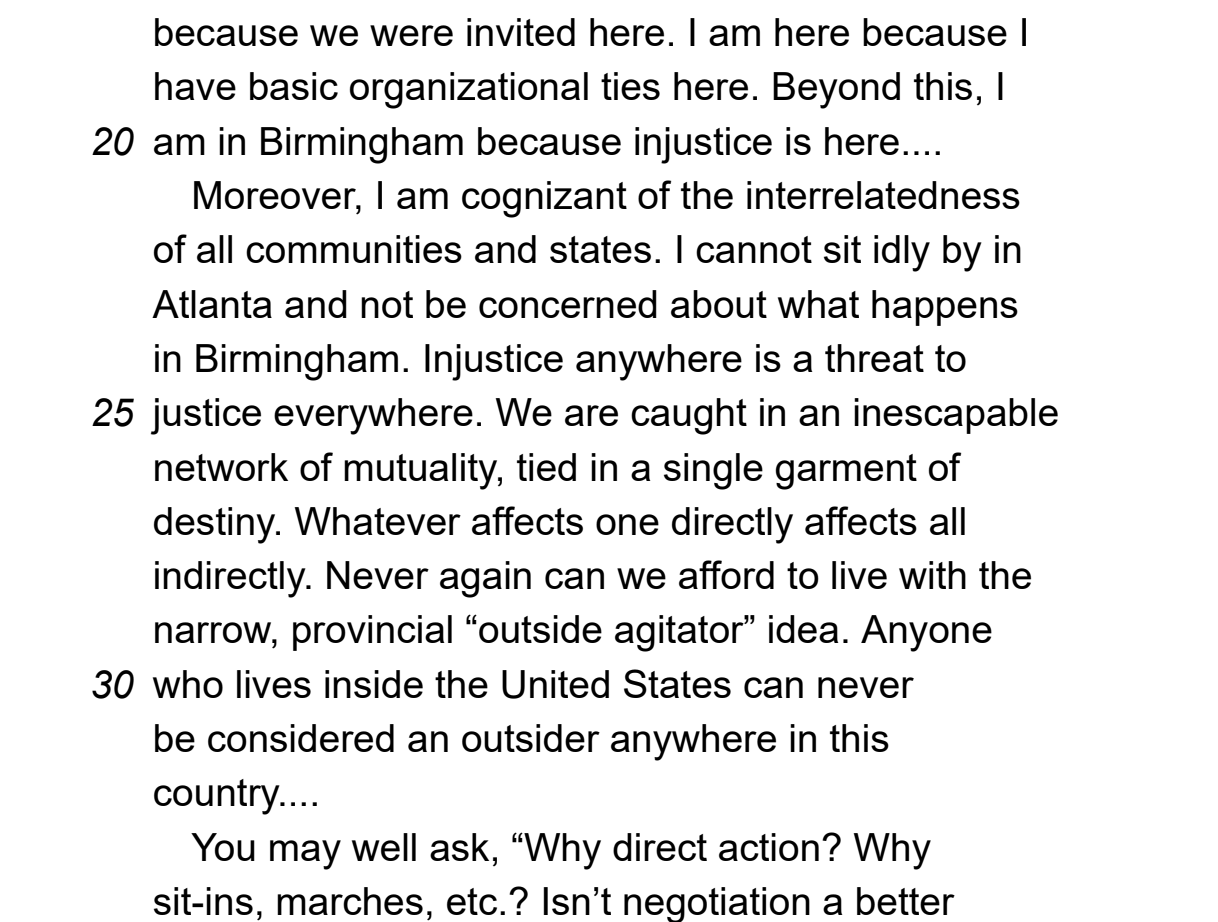
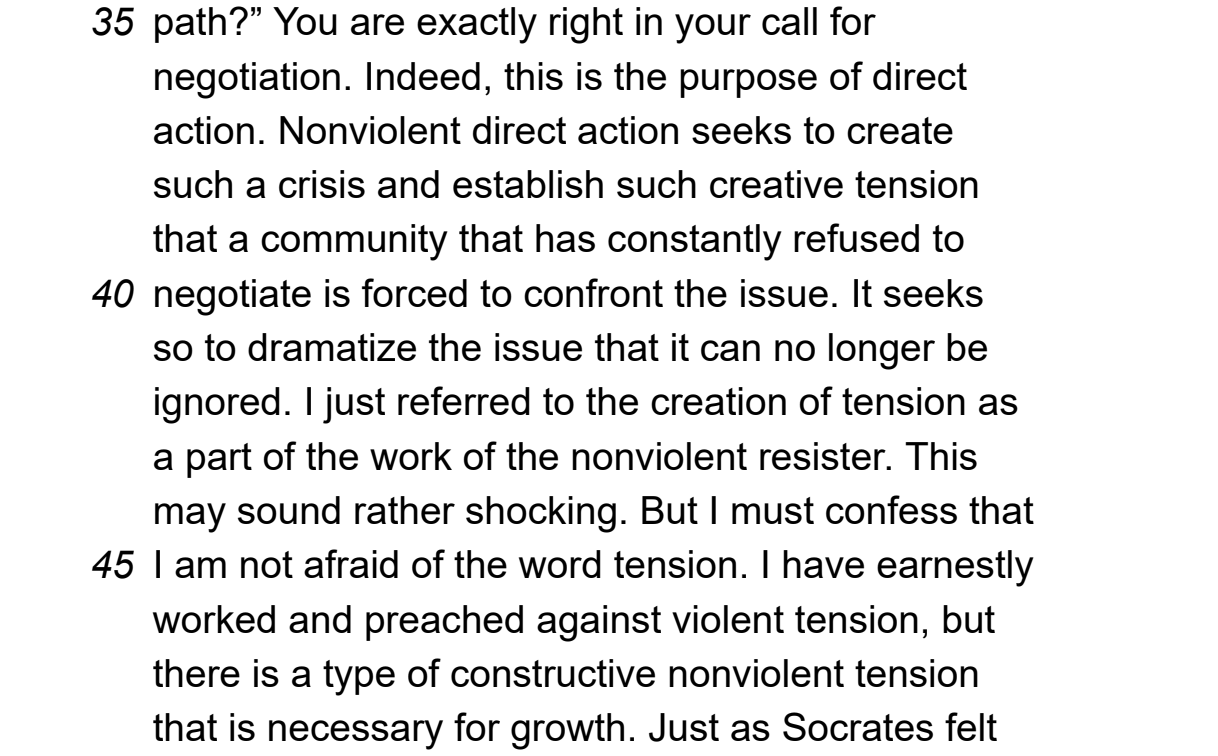
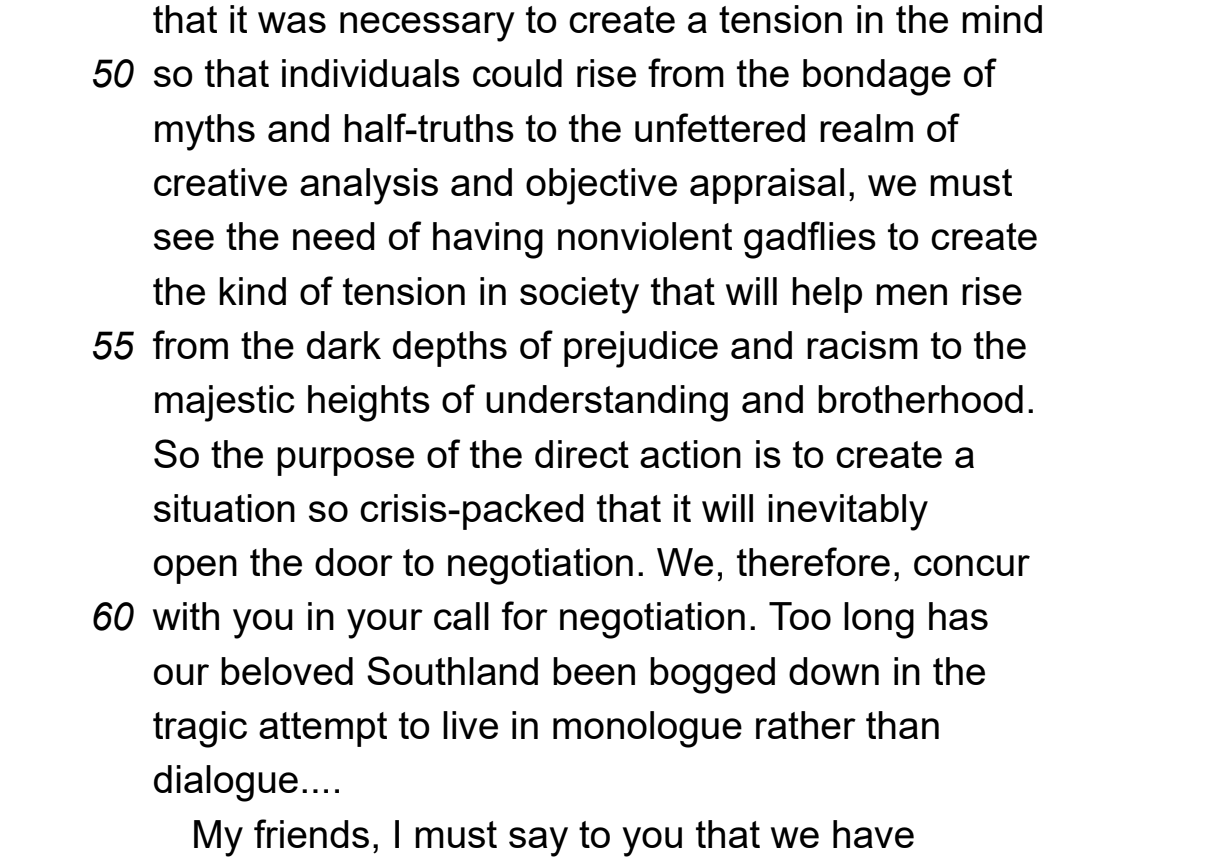
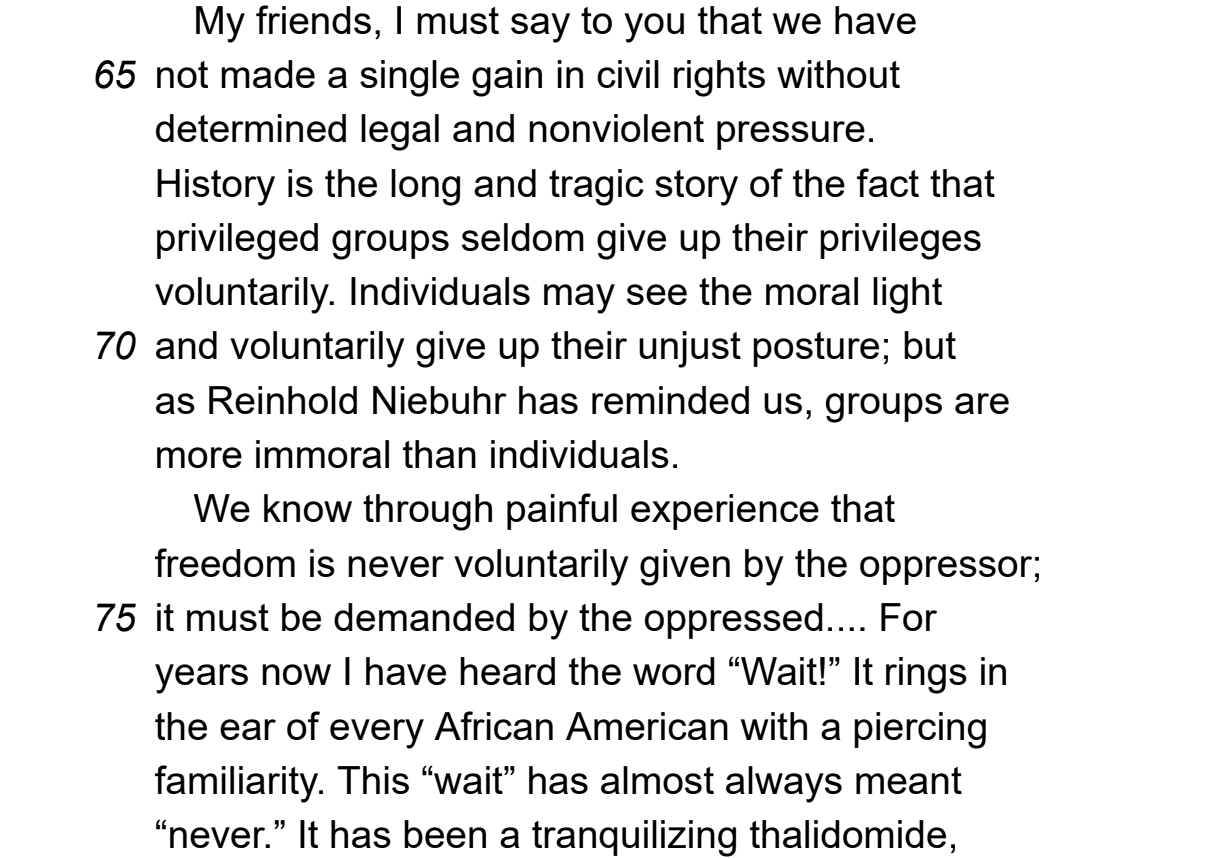
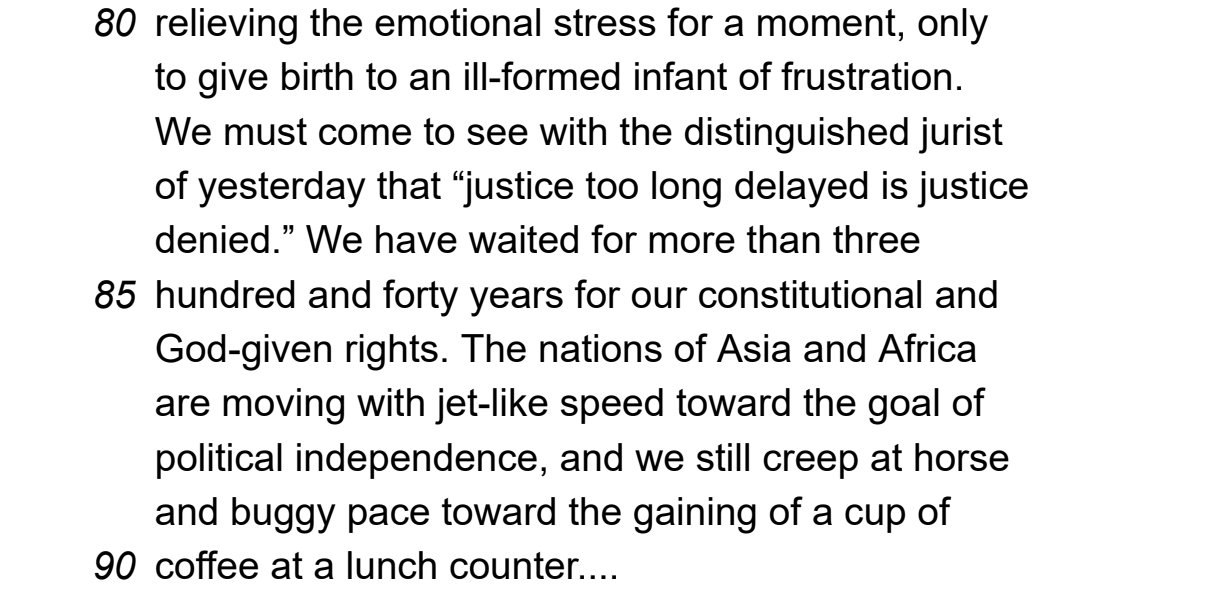
11. King’s purpose for writing this letter is
A) to explain why he came to Birmingham to protest.
B) to launch a nonviolent protest movement in Birmingham.
C) to open an affiliate of the Southern Christian Leadership Conference in Birmingham.
D) to support fellow civil rights activists in Birmingham
12. Which choice provides the best evidence for the answer to the previous question?
A) Lines 1–2 (“I think . . . in Birmingham”)
B) Lines 3–7 (“I have . . . Atlanta, Georgia”)
C) Lines 7–10 (“We have some . . . Rights”)
D) Lines 24–25 (“Injustice anywhere . . . everywhere”)
13. The passage most strongly suggests that which of the following statements is true?
A) King was warmly welcomed when he arrived in Birmingham.
B) King received criticism for his decision to come to Birmingham.
C) King did not want to cause a disruption by coming to Birmingham.
D) King was abandoned by his supporters when he arrived in Birmingham.
14. As used in lines 21–22, “interrelatedness of all communities and states” most nearly means that
A) King has personal connections to people in the town.
B) the Southern Christian Leadership Conference needs national support.
C) events in one part of the country affect everyone in the nation.
D) local civil rights groups operate independently of one another.
15. Based on paragraph 2, it can be reasonably inferred that King believed circumstances in Birmingham at the time
A) were unfair and wrong.
B) constituted an isolated event.
C) justified his arrest.
D) required federal intervention.
16. Which choice provides the best evidence for the answer to the previous question?
A) Lines 21–22 (“Moreover, . . . states”)
B) Lines 24–25 (“Injustice anywhere . . . everywhere”)
C) Lines 25–27 (“We are caught . . . destiny”)
D) Lines 28–29 (“Never again . . . idea”)
17. As used in line 41, “dramatize” most nearly means
A) cast events in an appealing light.
B) draw attention to significant events.
C) exaggerate events to seem more important.
D) turn events into a popular performance.
18. Which choice most clearly paraphrases a claim made by King in paragraph 3?
A) A failure to negotiate in the South has provoked secret action by civil rights activists
B) A focus on dialogue blinds reformers to the necessity for direct action to promote change
C) Direct action is necessary to motivate people to talk about prejudice and racism
D) Nonviolent protest encourages a sense of brotherhood and understanding among citizens
19. Paragraph 4 best supports the claims made in paragraph 3 by
A) arguing that nonviolent pressure is most likely to spur just action by individuals.
B) clarifying that throughout history, privileged classes have been reluctant to let go of privilege.
C) drawing a distinction between the morality of individuals and of groups.
D) pointing out that few gains in civil rights have been made without nonviolent pressure.
20. King refers to “the gaining of a cup of coffee at a lunch counter” (lines 89–90) primarily to
A) call attention to the sedative effect of delaying civil rights reform in the United States.
B) emphasize that white Americans will not willingly end oppression against black Americans.
C) describe the progress made toward the winning of equal rights in other countries.
D) underscore the contrast between progress made in other countries and the United States.
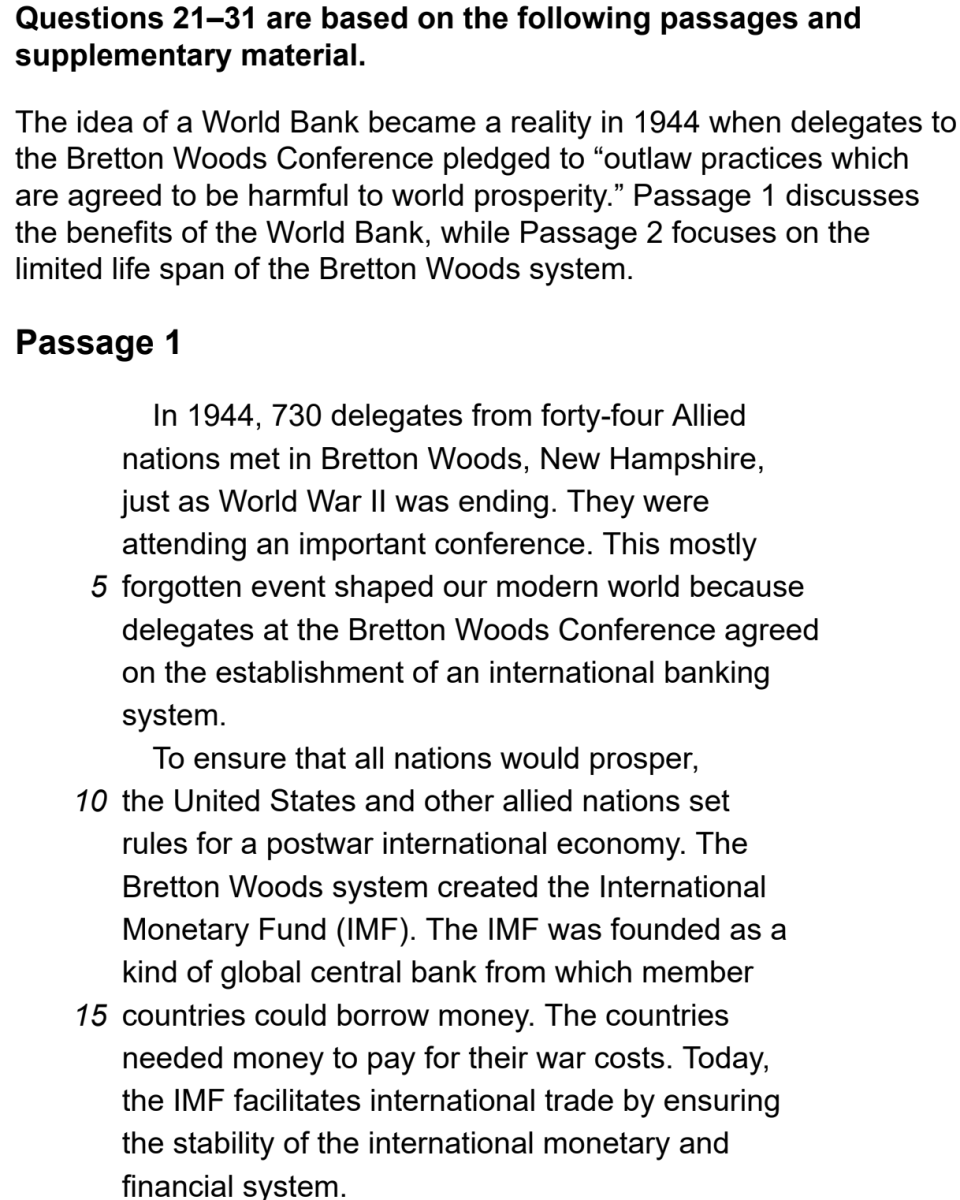
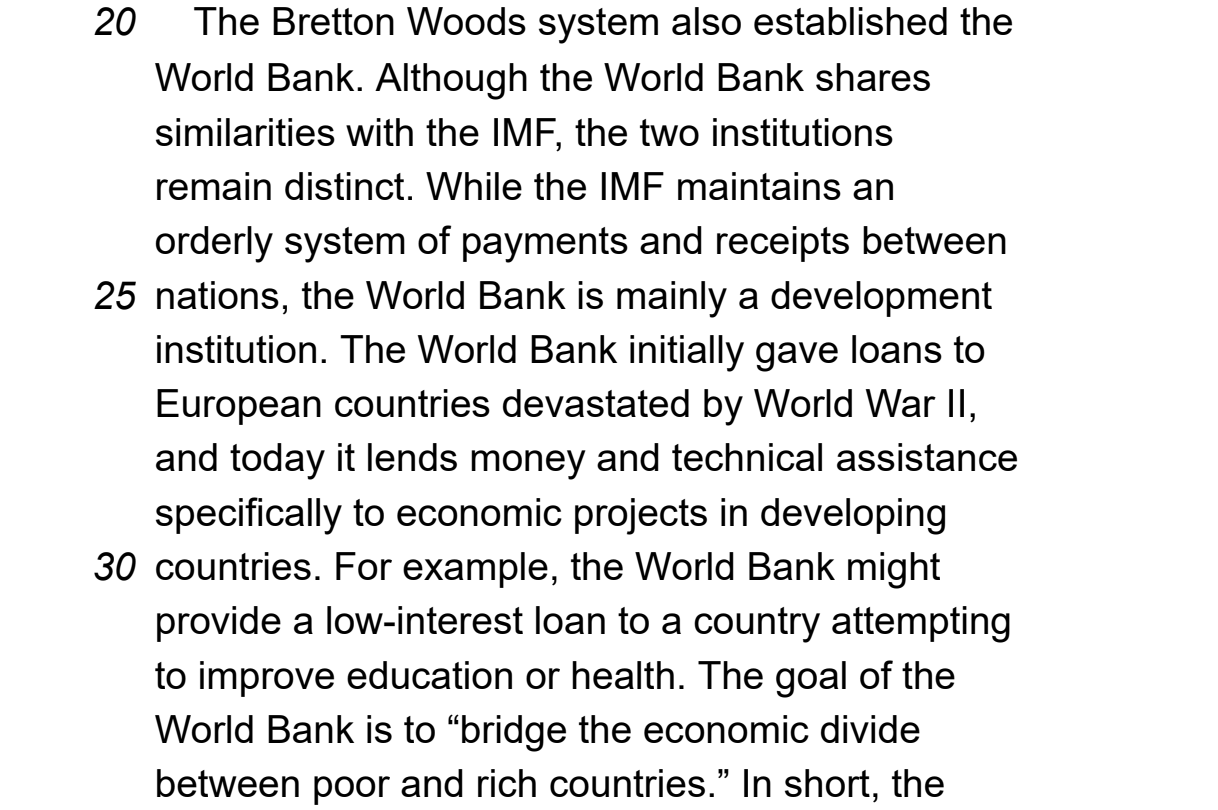
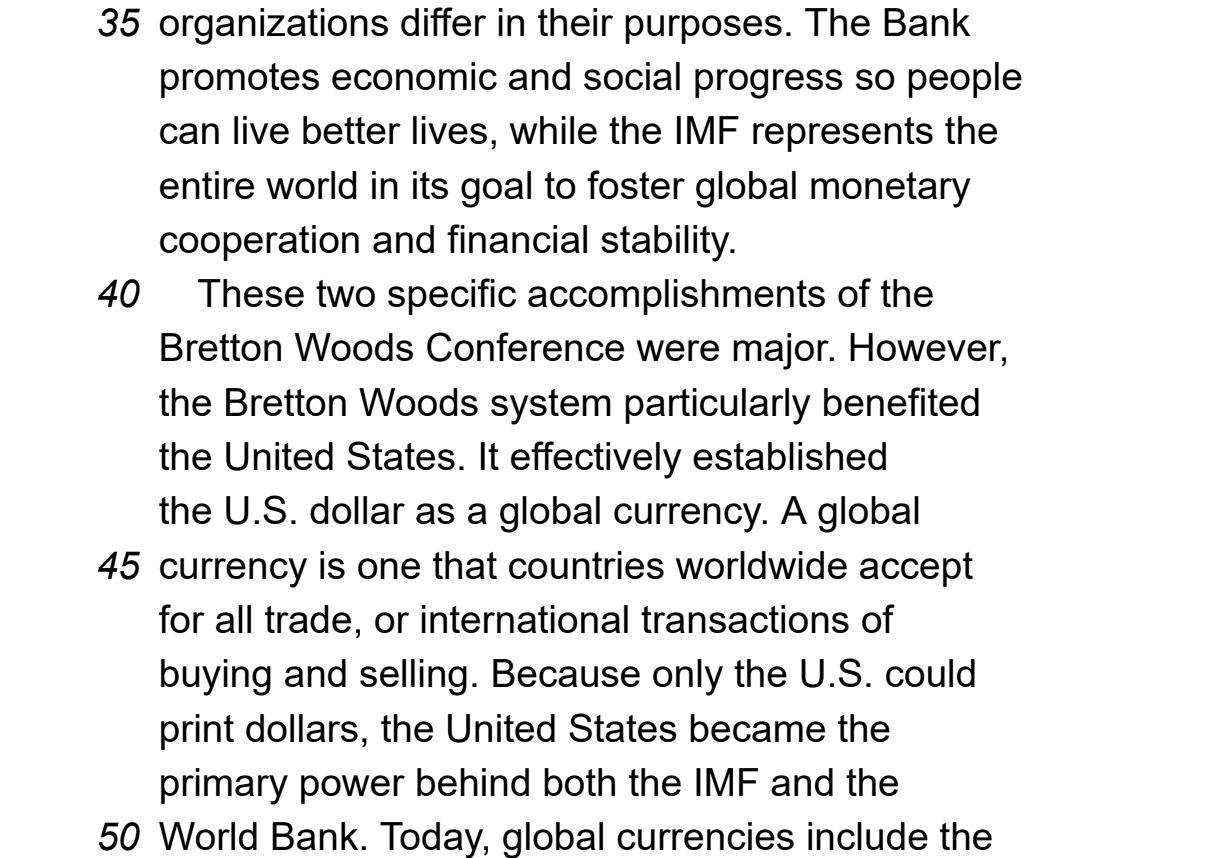
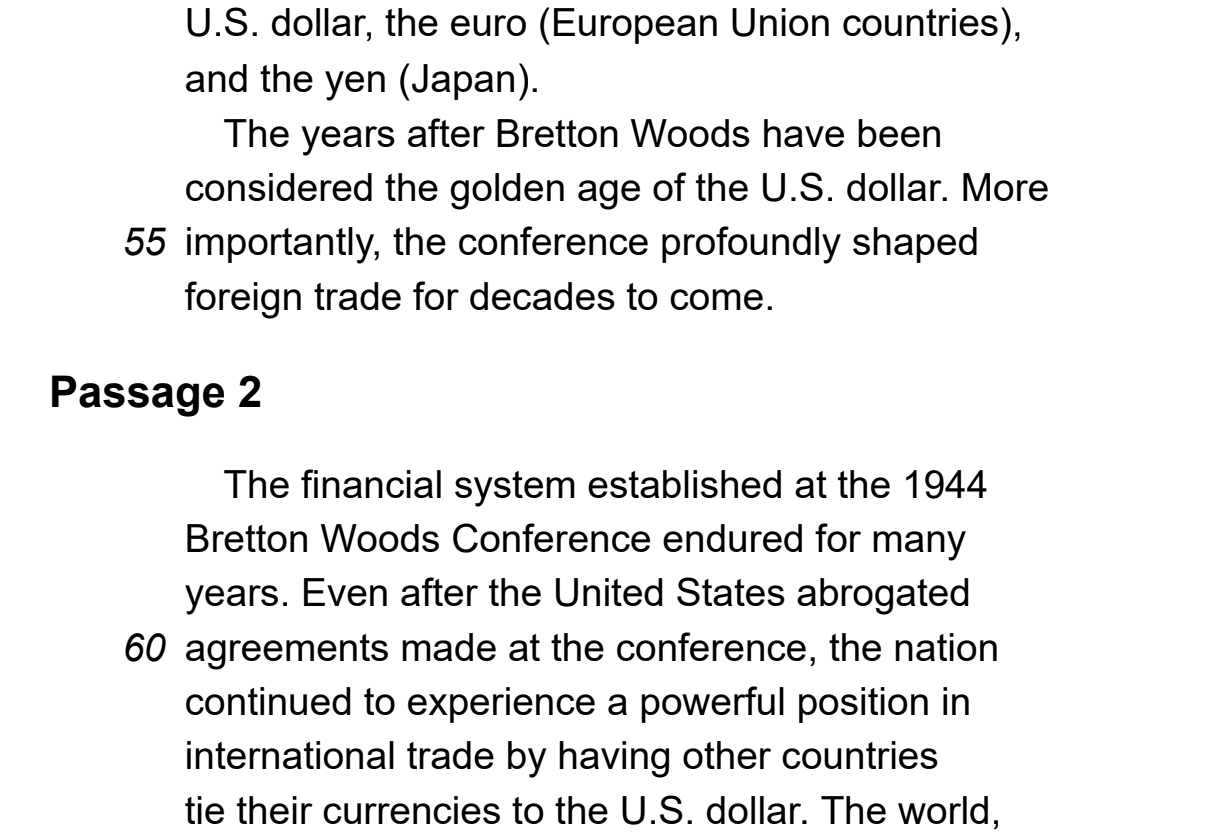
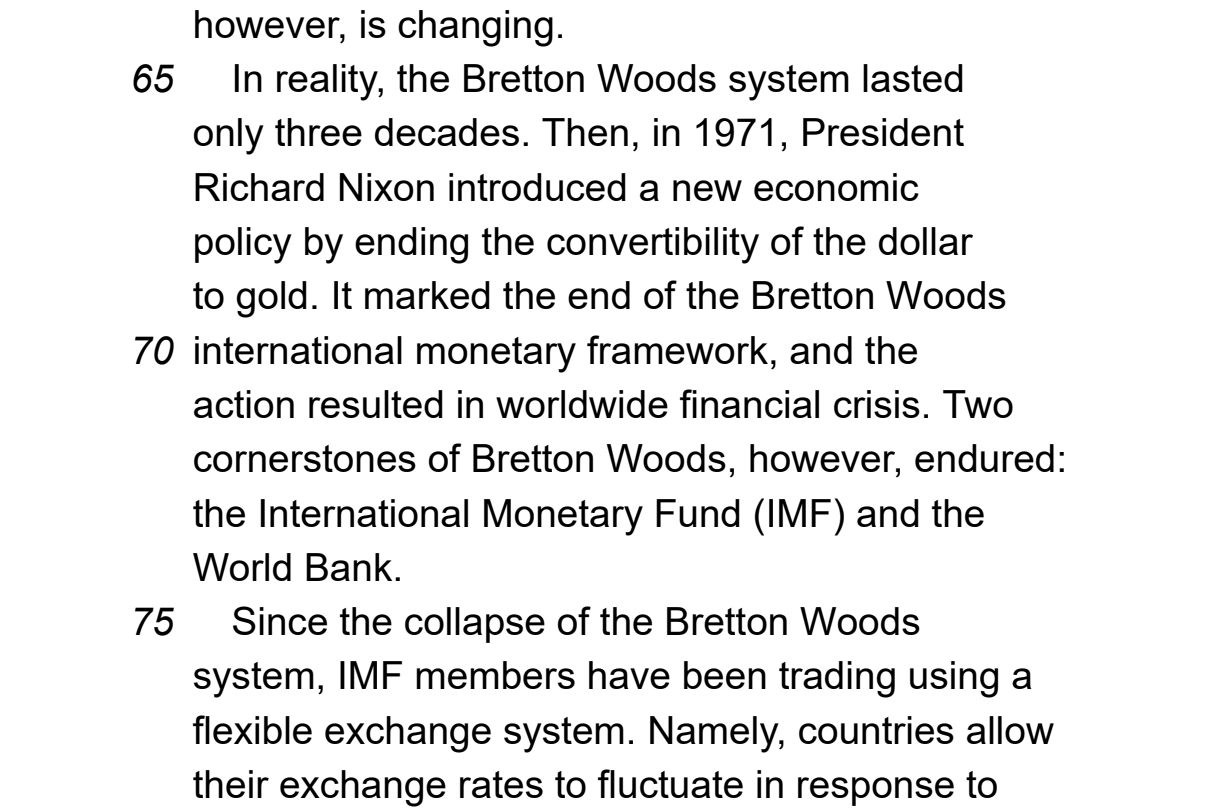
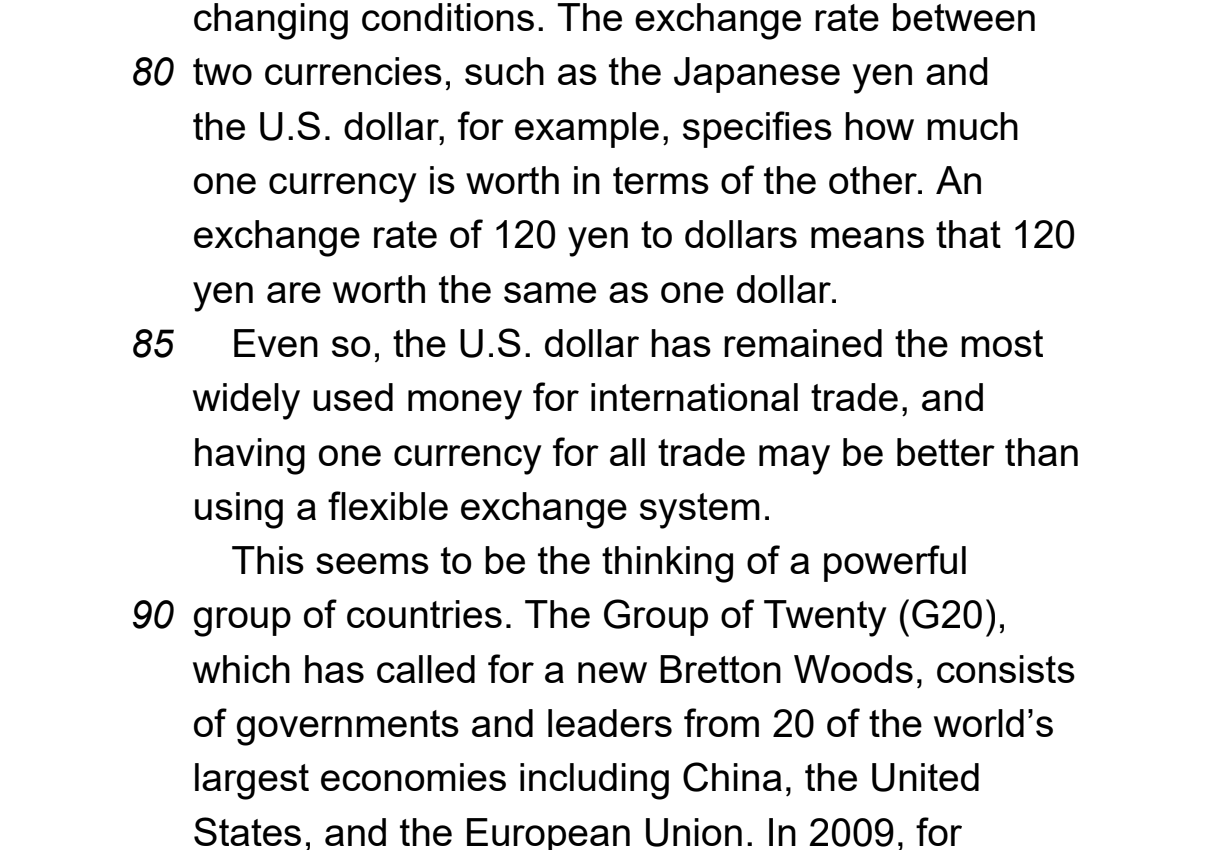

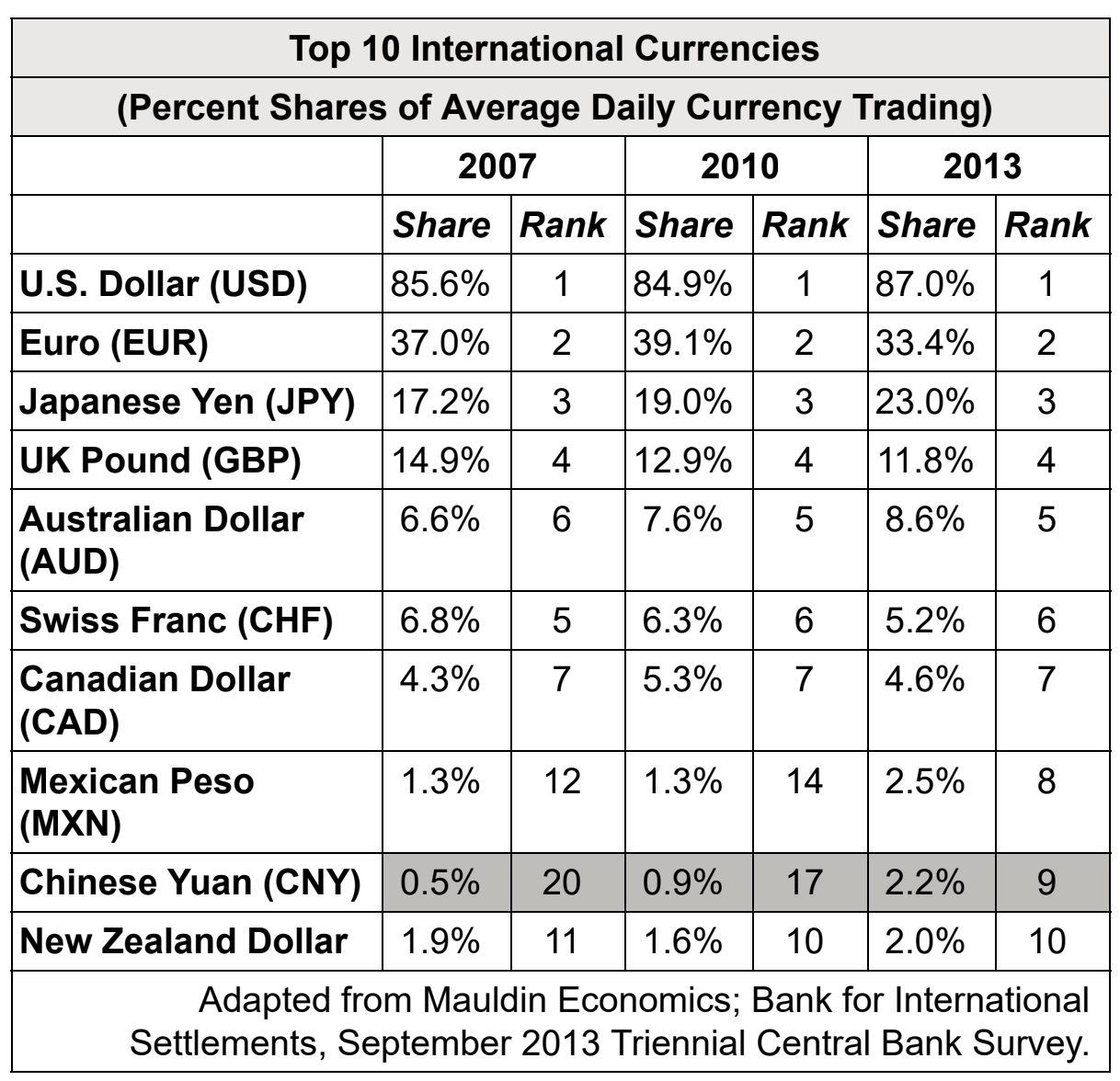
21. Based on Passage 1, it can reasonably be inferred that
A) world leaders recognized the need for markets to function independently.
B) Bretton Woods increased U.S. economic influence around the world.
C) the IMF and the World Bank work closely together to ensure prosperity.
D) the conclusion of World War II had little influence on events at Bretton Woods.
22. Which choice provides the best evidence for the answer to the previous question?
A) Lines 9–11 (“To ensure . . . economy”)
B) Lines 11–13 (“The Bretton . . . Fund”)
C) Lines 47–50 (“Because only . . . World Bank”)
D) Lines 54–56 (“More importantly . . . to come”)
23. As used in line 38, “foster” most nearly means
A) publicize.
B) rear.
C) stabilize.
D) encourage.
24. Which statement best explains the difference between the purposes of the IMF and the World Bank?
A) The IMF provides money to pay for war costs, while the World Bank offers assistance to rebuild countries recovering from war across the globe.
B) The IMF encourages stability in the global financial system, while the World Bank promotes economic development in relatively poor nations.
C) The IMF supports the U.S. dollar in international markets, while the World Bank provides low-interest loans to many nations around the world.
D) The IMF offers governments advice about participation in global markets, while the World Bank encourages monetary cooperation between nations.
25. Based on the second paragraph in Passage 2, it can be reasonably inferred that
A) the United States did not support the goals of the IMF and the World Bank.
B) Bretton Woods was originally intended to last for three decades.
C) President Nixon acted to reinforce the decisions made at Bretton Woods.
D) some U.S. policy decisions differed from international consensus over Bretton Woods.
26. Which choice provides the best evidence for the answer to the previous question?
A) Lines 65–66 (“In reality . . . three decades”)
B) Lines 66–69 (“Then, in 1971 . . . to gold”)
C) Lines 71–74 (“Two cornerstones . . . World Bank”)
D) Lines 75–77 (“Since the collapse . . . exchange system”)
27. As used in line 97, “anchor” most nearly means
A) key.
B) fastening.
C) rigid.
D) supporting.
28. It can reasonably be inferred from both Passage 2 and the graphic that
A) international markets are increasingly comfortable using the yuan as trade currency.
B) the United States favors using the yuan as one of the world’s reserve currencies.
C) the G20 wants to replace the yuan and other currencies with a new global currency.
D) the IMF continues to support the yuan and other currencies in a flexible exchange system.
29. The last paragraph of Passage 2 can be described as
A) a refutation of opponents’ criticisms.
B) an indication of the author’s opinion.
C) a summary of the author’s main points.
D) an introduction of a contradictory position.
30. Which statement most effectively compares the authors’ purposes in both passages?
A) Passage 1’s purpose is to contrast the functions of the IMF and World Bank, while Passage 2’s purpose is to outline the benefits of a flexible trade system to the United States.
B) Passage 1’s purpose is to describe the history of international trade in the 20th century, while Passage 2’s purpose is to explain why the Bretton Woods system collapsed.
C) Passage 1’s purpose is to describe Bretton Woods’s effect on the global economy, while Passage 2’s purpose is to suggest that a new currency for global trade may soon be implemented.
D) Passage 1’s purpose is to promote the economic benefits of the IMF and World Bank, while Passage 2’s purpose is to encourage the reestablishment of the Bretton Woods system.
31. Both passages support which generalization about the global economy?
A) U.S. influence on global trade has continued under a flexible exchange system.
B) The purposes of the International Monetary Fund and the World Bank are indirectly related.
C) The Group of Twenty represents the financial interests of the world’s largest economies.
D) International institutions such as the IMF continue to influence economic trade and development.
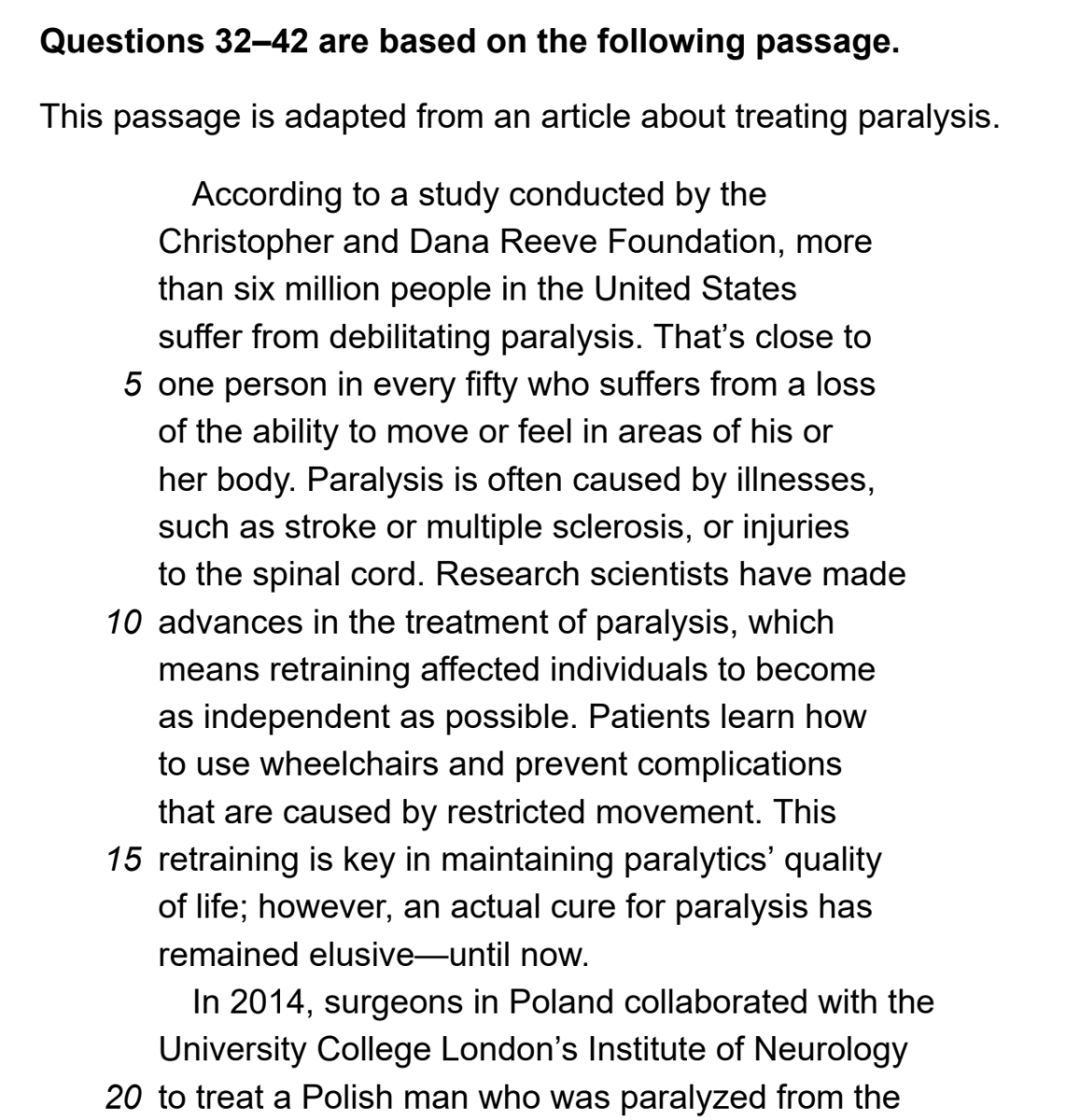
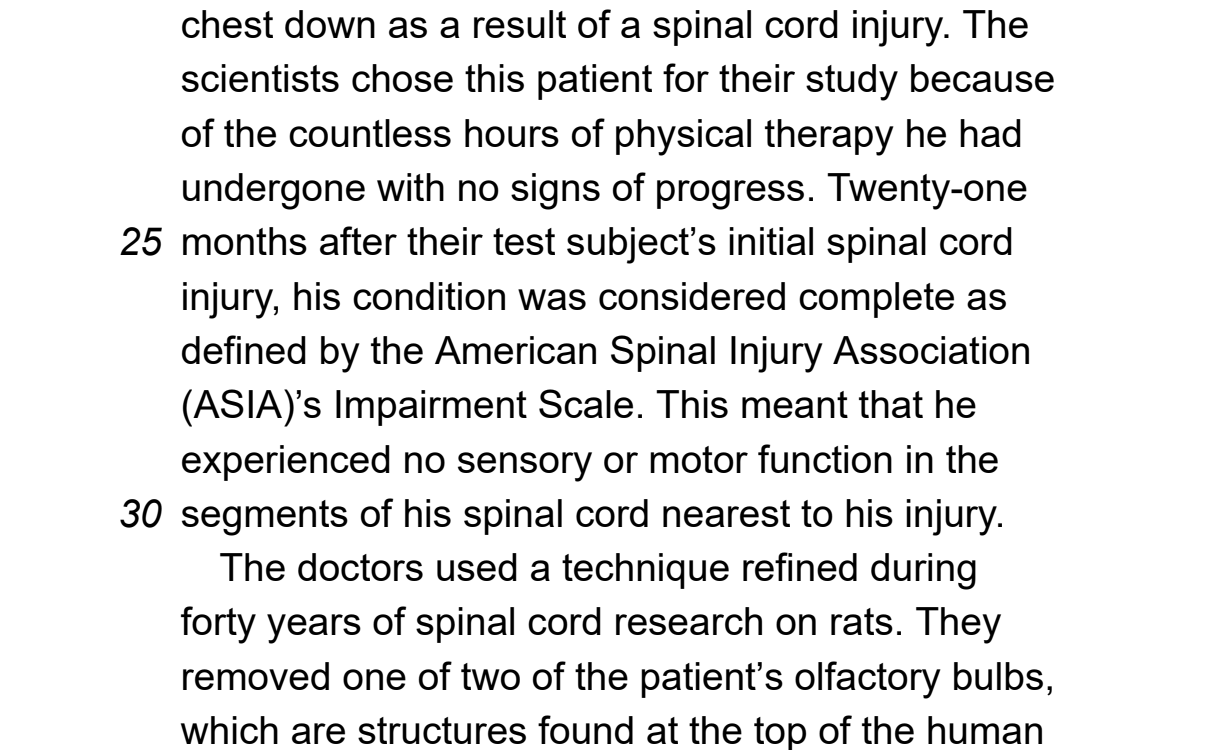

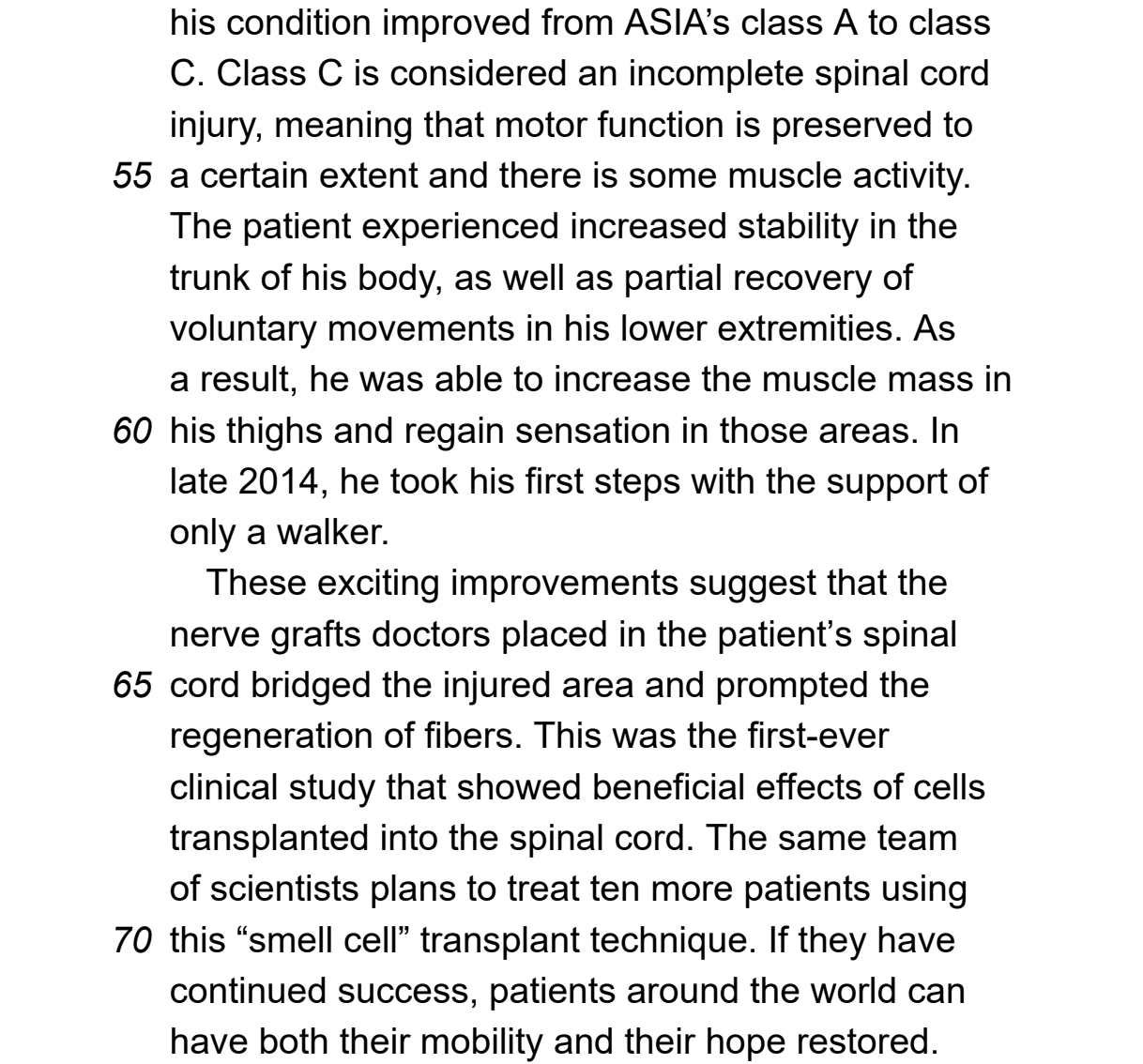
32. The passage is primarily concerned with
A) how various diseases and injuries can cause permanent paralysis.
B) ways in which doctors and therapists work to improve patients’ quality of life.
C) one treatment being developed to return mobility to patients suffering paralysis.
D) methods of physical therapy that can help patients with spinal cord injuries.
33. The author includes a description of retraining paralytics in lines 9–14 primarily to
A) describe how people with paralysis cope with everyday tasks.
B) appeal to the reader’s sympathies for people with paralysis.
C) show that most research scientists do not believe a cure can be found.
D) help readers appreciate the significance of research that may lead to a cure.
34. Based on the information in the passage, it can be inferred that the author
A) believes more research should be done before patients with paralysis are subjected to the treatment described in the passage.
B) feels that increased mobility will have a positive impact on patients suffering from all levels of paralysis.
C) thinks that more scientists should study paralysis and ways to improve the quality of life for patients with limited mobility.
D) was part of the research team that developed the new method of treating paralysis described in the passage.
35. Which choice provides the best support for the answer to the previous question?
A) Lines 7–9 (“Paralysis is . . . spinal cord”)
B) Lines 18–21 (“In 2014 . . . injury”)
C) Lines 56–58 (“The patient . . . extremities”)
D) Lines 70–72 (“If they . . . restored”)
36. As used in line 14, “restricted” most nearly means
A) confidential.
B) dependent.
C) increased.
D) limited.
37. In line 49, the author’s use of the word “tailor-made” helps reinforce the idea that
A) the injected cells were from the patient and were therefore well-suited to work in his own body.
B) spinal cord cells were replaced during the transplant portion of the individualized treatment.
C) olfactory bulbs were removed from rats and placed in the patient’s spinal cord during surgery.
D) the method used by doctors to locate the damaged
area required expertise and precision.
38. It reasonably can be inferred from the passage that
A) the patient’s treatment would have been more successful if scientists had used cells from another area of his body instead of from his olfactory bulbs.
B) cells from olfactory bulbs will be used to cure diseases that affect areas of the body other than the spinal cord.
C) the patient who received the experimental treatment using cells from olfactory bulbs would not have regained mobility without this treatment.
D) soon doctors will be able to treat spinal injuries without time-consuming and demanding physical therapy.
39. Which choice provides the best evidence for the answer to the previous question?
A) Lines 9–12 (“Research scientists . . . possible”)
B) Lines 21–24 (“The scientists . . . progress”)
C) Lines 32–35 (“They removed . . . nose”)
D) Lines 63–66 (“These exciting . . . fibers”)
40. As used in line 31, “refined” most nearly means
A) advanced.
B) improved.
C) experienced.
D) treated.
41. The success of the patient’s treatment was due in large part to
A) studies done on other patients.
B) research conducted by other doctors in Poland.
C) many experiments performed on rats.
D) multiple attempts on various types of animals.
42. The procedure described in which cells from olfactory bulbs are injected into a damaged area of the spinal cord is most analogous to which of the following?
A) Replacing a diseased organ in a patient with an organ from a donor who has the same tissue type
B) Giving a patient with a high fever an injection of medication to bring the core body temperature down
C) Placing a cast on a limb to hold the bone in place to encourage healing after suffering a break
D) Grafting skin from a healthy area of the body and transplanting it to an area that has suffered severe burns
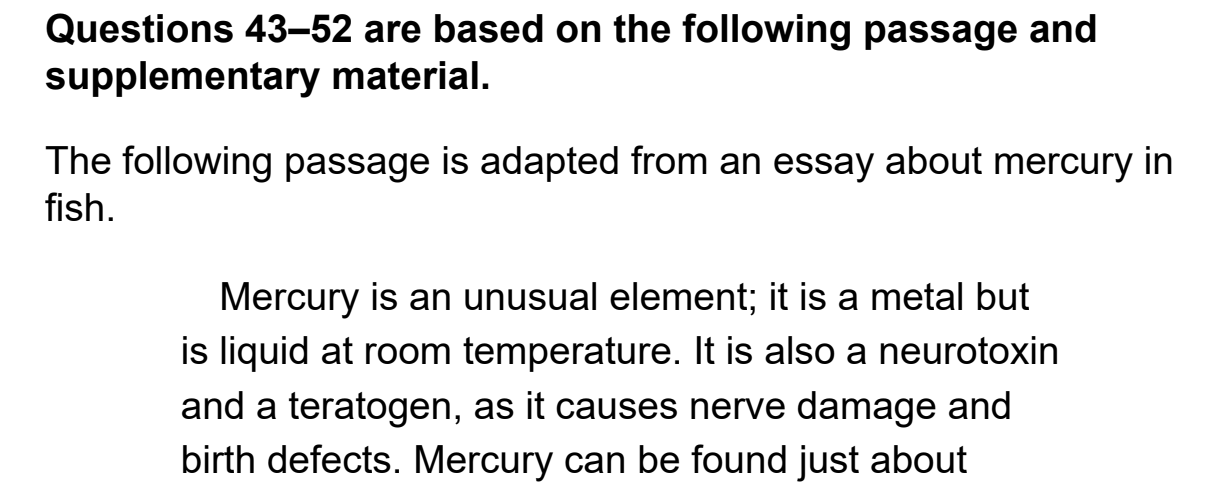
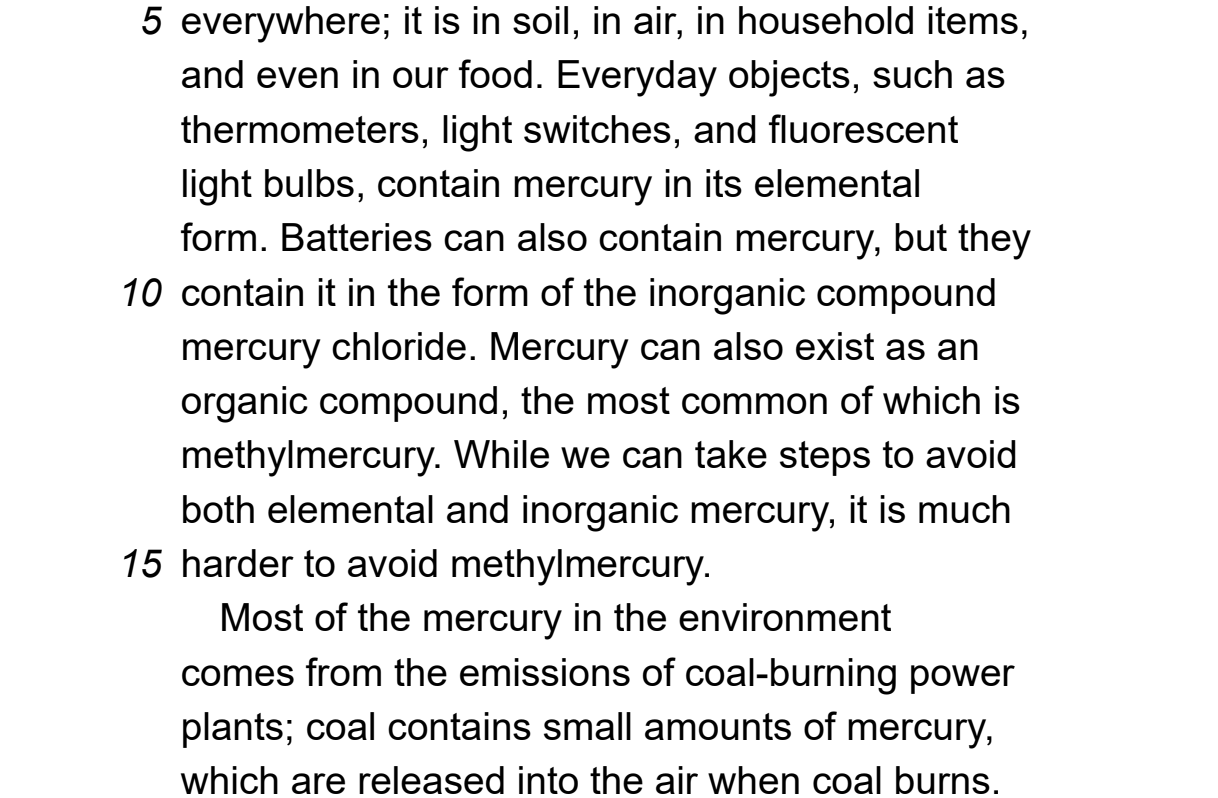
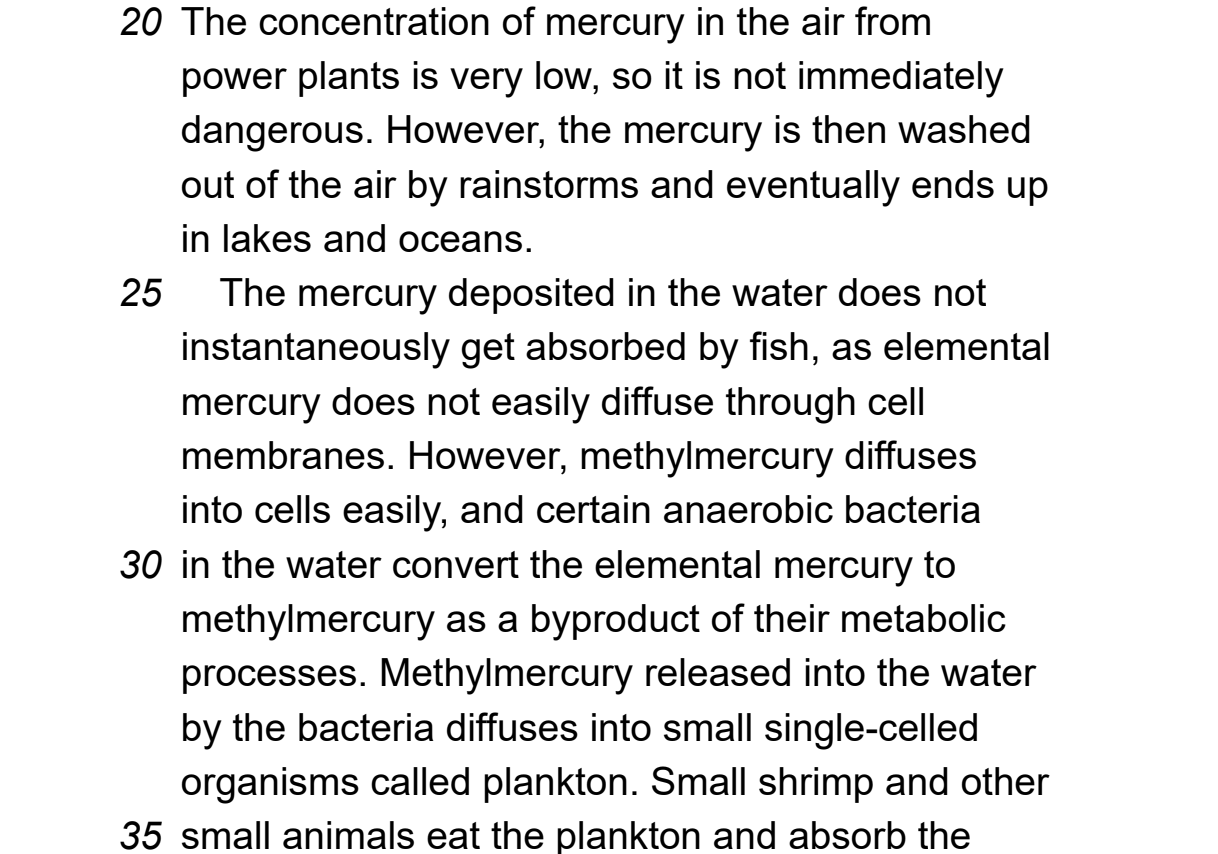
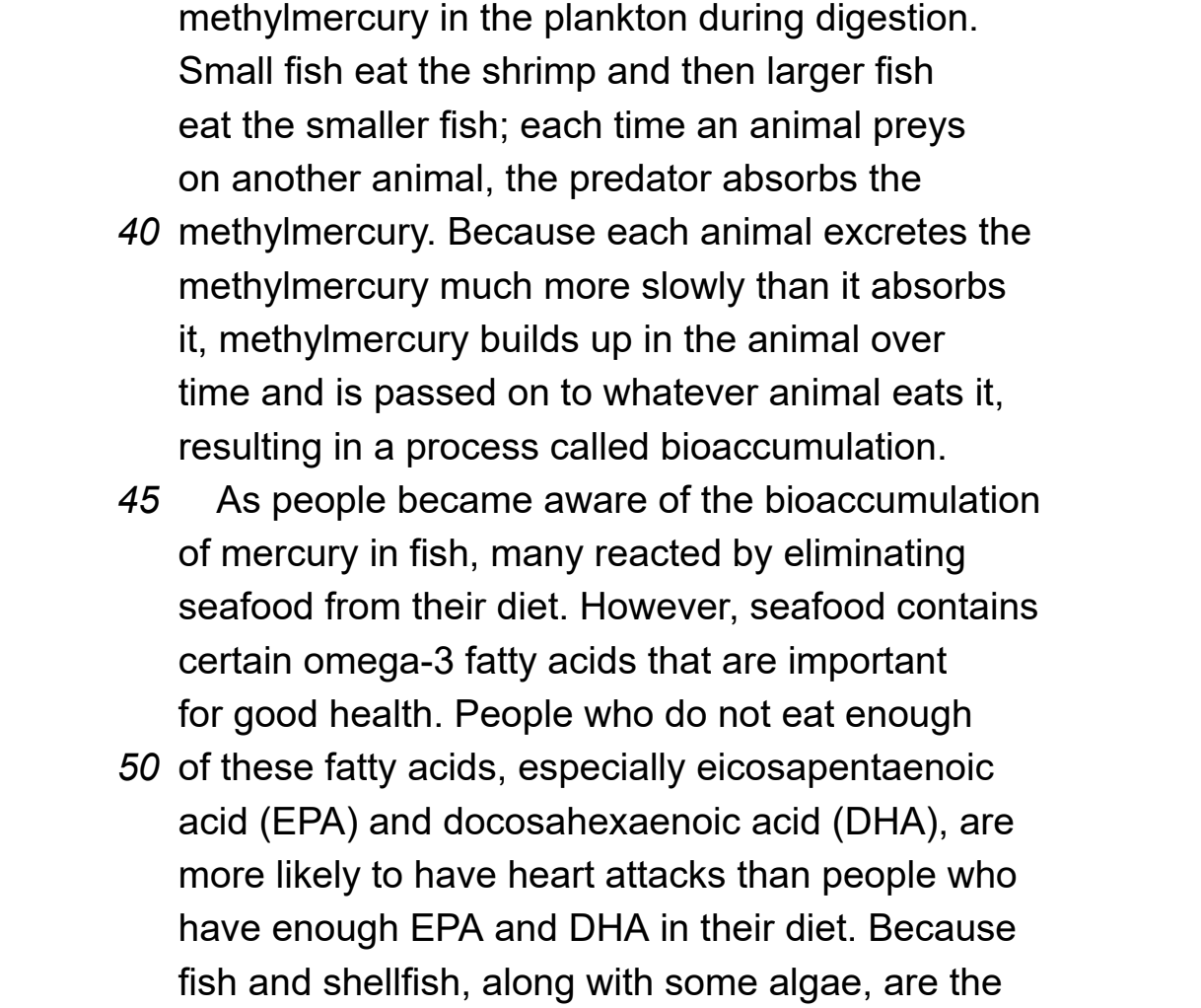
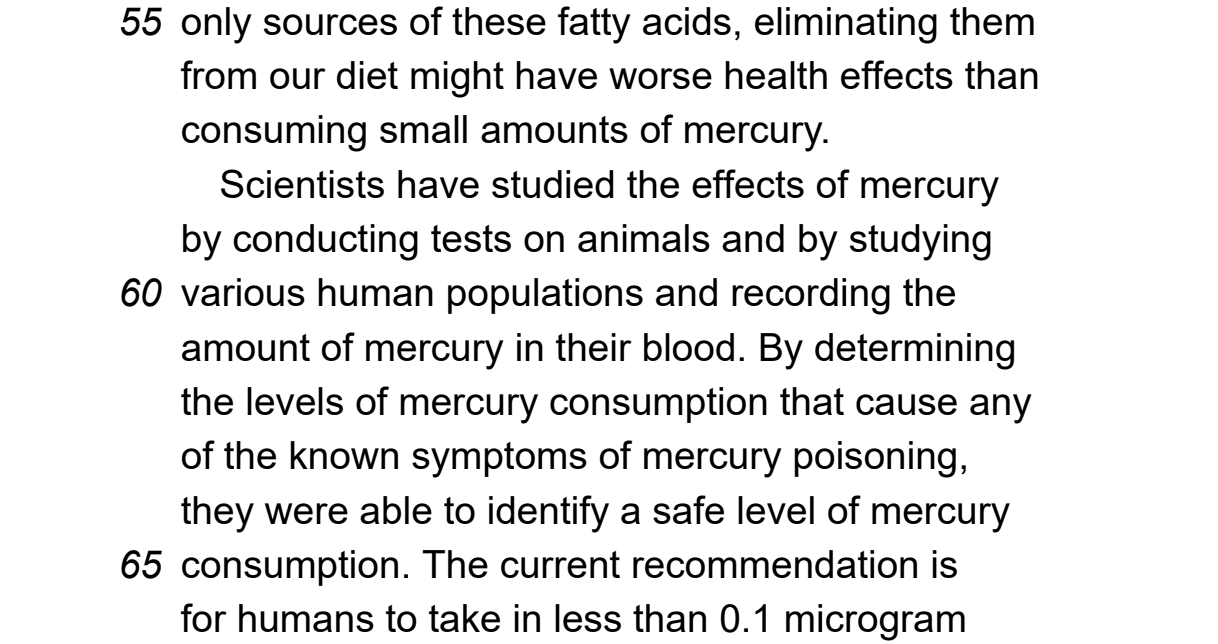
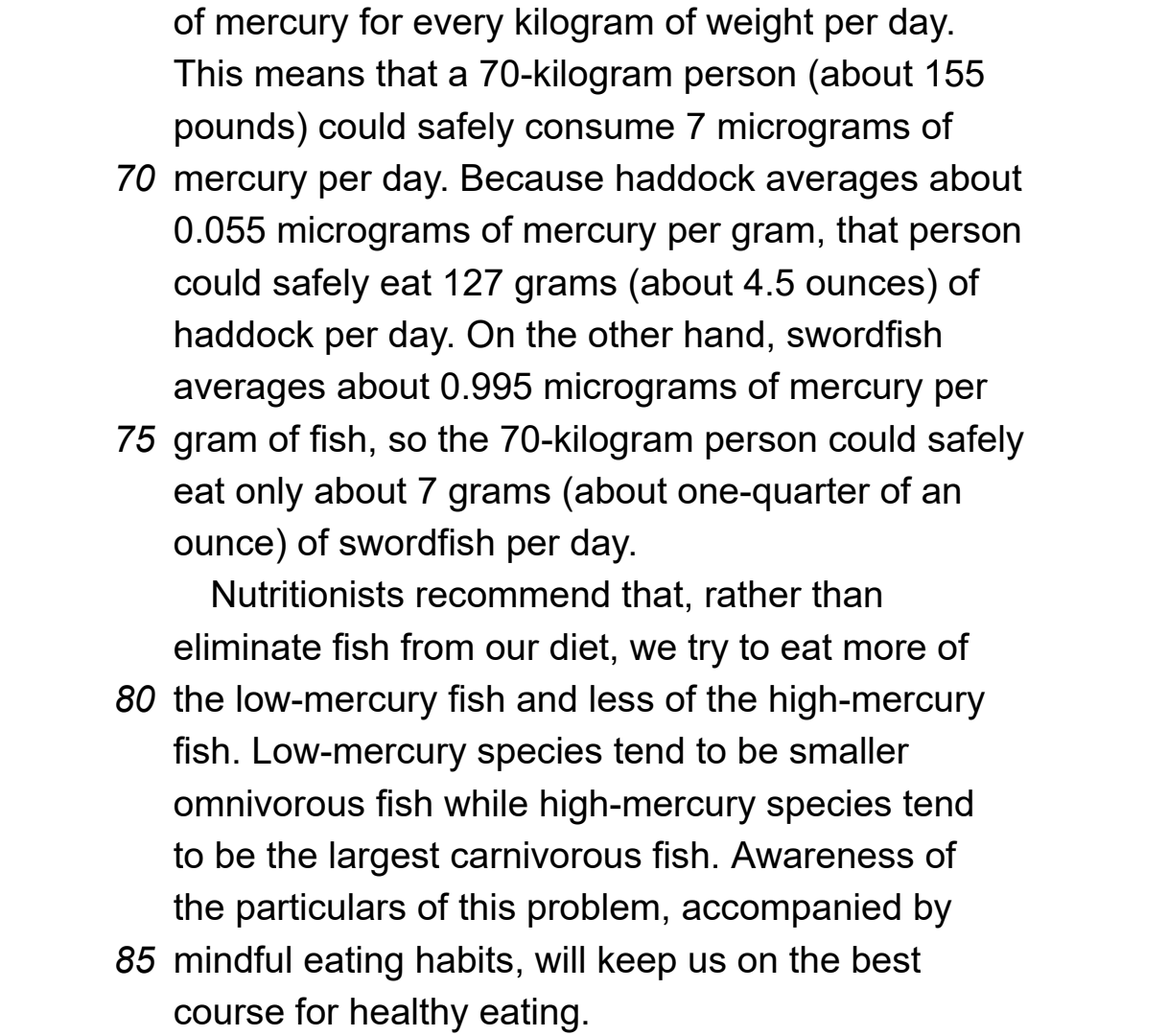
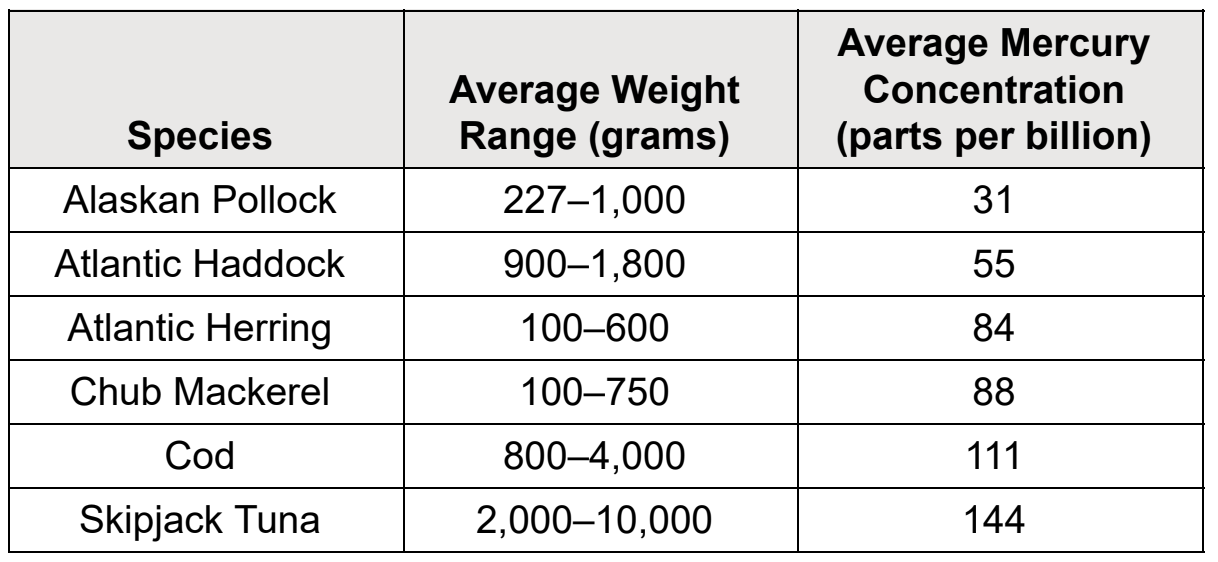

43. The author of the passage would most likely agree with which of the following statements?
A) Mercury poisoning is only one of many concerns that should be considered when choosing which fish to add to one’s diet.
B) More should be done by scientists and nutritionists to inform people about the dangers of mercury poisoning.
C) Fish is an essential part of a healthy diet and can be eaten safely if recommendations for mercury consumption are kept in mind.
D) The mercury present in the air is more dangerous to people than the mercury consumed by eating fish with high mercury levels.
44. Which choice provides the best evidence for the answer to the previous question?
A) Lines 16–18 (“Most of . . . plants”)
B) Lines 32–34 (“Methylmercury released . . . plankton”)
C) Lines 58–61 (“Scientists . . . their blood”)
D) Lines 83–86 (“Awareness . . . eating”)
45. In addition to the levels of mercury in a specific species of fish, people should also consider which of the following when determining a safe level of consumption?
A) Their own body weight
B) Where the fish was caught
C) The other meats they are eating
D) What they ate the day before
46. As used in line 20, “concentration” most nearly means
A) focus.
B) application.
C) density.
D) awareness.
47. The passage most strongly suggests which of the following statements is accurate?
A) It is not possible to completely avoid environmental exposure to mercury.
B) Inorganic mercury is more dangerous to humans than organic mercury.
C) Most of the exposure to mercury experienced by humans comes from fish consumption.
D) Mercury is one of the most abundant elements found in nature.
48. Which choice provides the best evidence for the answer to the previous question?
A) Lines 1–2 (“Mercury is an unusual . . . temperature”)
B) Lines 4–6 (“Mercury . . . our food”)
C) Lines 20–22 (“The concentration . . . dangerous”)
D) Lines 28–32 (“However, methylmercury . . . processes”)
49. The main purpose of paragraph 3 is to explain
A) the reasons why mercury deposited in water is not harmful to fish.
B) the relationships between predators and prey in aquatic animals.
C) how the largest fish accumulate the greatest amounts of mercury.
D) the difference between methylmercury and other types of mercury.
50. Which of the following pieces of evidence would most strengthen the author’s line of reasoning?
A) More examples in paragraph 1 of places mercury is found
B) Details in paragraph 2 about the levels of mercury found in the air
C) An explanation in paragraph 4 of how to treat mercury poisoning
D) More examples in paragraph 5 of how many micrograms of mercury people of different weights could eat
51. As used in line 84, “particulars” most nearly means
A) data.
B) specifics.
C) points.
D) evidence.
52. Based on the information in the passage and the graphic, which of the following statements is true?
A) The fish with the lowest average weight is the safest to eat.
B) A person can safely eat more marlin than albacore tuna in one day.
C) Eating large fish carries a lower risk of mercury poisoning than eating small fish.
D) A person can safely eat more Alaskan pollock than black-striped bass in one day.


